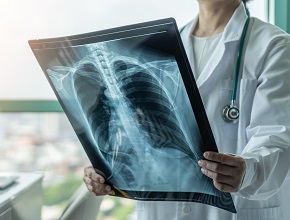Trastornos funcionales
Todavía no se ha publicado ningún estudio sobre la influencia a largo plazo de la COVID-19 y la función pulmonar, pero ya han aparecido las primeras observaciones sobre el período de recuperación. En un estudio con 110 pacientes hospitalizados por COVID-19, en su mayoría leve o moderada (solo el 17 % tenía COVID-19 grave), casi la mitad presentaron una reducción de la capacidad de difusión de monóxido de carbono (TLCO). No obstante, conviene señalar que las pruebas funcionales se realizaron relativamente poco tiempo después del inicio de la enfermedad (de media 20 días en los casos leves, hasta 34 días en los graves). Los niveles de TLCO fueron peores en los pacientes con enfermedad grave. En una cohorte de pacientes observados durante 12 meses, los niveles de TLCO mejoraron con el paso del tiempo (mediana del 77 % del valor de referencia después de 3 meses y 88 % del valor de referencia después de 12 meses).
Al valorar en conjunto los resultados de los ensayos realizados hasta la fecha, se ha observado que el trastorno más frecuente después de la COVID-19 es la reducción de la TLCO, que afecta a aproximadamente un 40 % de los pacientes. El trastorno ventilatorio más frecuente es el restrictivo (en aprox. 15 %), mientras que el obstructivo se observa con menos de la mitad de frecuencia (en aprox. 7 %).
Las observaciones propias del autor (P.B.), con una cohorte de 100 pacientes que sufrieron neumonía secundaria a infección por SARS-CoV-2 confirmada (datos sin publicar), señalan que la frecuencia de los trastornos funcionales es similar.
Bibliografía:
1. Yang X., Yu Y., Xu J. y cols., Clinical course and outcomes of critically ill patients with SARS-CoV-2 pneumonia in Wuhan, China: a single-centered, retrospective, observational study, Lancet Respir. Med., 2020; 8: 475-481. doi: 10.1016/S2213-2600(20)30079-52. Grasselli G., Zangrillo A., Zanella A. y cols., Baseline characteristics and outcomes of 1591 patients infected with SARS-CoV-2 admitted to ICUs of the Lombardy Region, Italy, JAMA, 2020; 323: 1574-1581. doi: 10.1001/jama.2020.5394
3. Mehta P., McAuley D.F., Brown M. y cols., COVID-19: consider cytokine storm syndromes and immunosuppression, Lancet, 2020; 395: 1033-1034. doi: 10.1016/ S0140-6736(20)30628-0
4. Guan W.J., Ni Z.Y., Hu Y. y cols., Clinical characteristics of coronavirus disease 2019 in China, N. Engl. J. Med., 2020; 382: 1708-1720. doi: 10.1056/NE JMoa2 002 032
5. Cheng V.C.C., Lau S.K.P., Woo P.C.Y., Yuen K.Y., Severe acute respiratory syndrome coronavirus as an agent of emerging and reemerging infection, Clin. Microbiol. Rev., 2007; 20: 660-694. doi: 10.1128/CMR.00 023-07
6. Chan-Yeung M., Xu R.-H., SARS: epidemiology, Respirology (Carlton, Vic.), 2003; 8 (suppl. 1): S9-S14. doi: 10.1046/j.1440-1843.2003.00 518.x
7. Ramadan N., Shaib H., Middle East respiratory syndrome coronavirus (MERS-CoV): a review, Germs, 2019; 9: 35-42. doi: 10.18683/germs.2019.1155
8. Ooi G.C., Khong P.L., Müller N.L. y cols., Severe acute respiratory syndrome: temporal lung changes at thin-section CT in 30 patients, Radiology, 2004; 230: 836-844. doi: 10.1148/radiol.2 303 030 853
9. Ketai L., Paul N.S., Wong K.T., Radiology of severe acute respiratory syndrome (SARS): the emerging pathologic-radiologic correlates of an emerging disease, J. Thorac. Imaging, 2006; 21: 276-283. doi: 10.1097/01.rti.0000213581.14225.f1
10. Chang Y.C., Yu C.J., Chang S.C. y cols., Pulmonary sequelae in convalescent patients after severe acute respiratory syndrome: evaluation with thin-section CT, Radiology, 2005; 236: 1067-75. doi: 10.1148/radiol.2 363 040 958
11. Hui D.S., Joynt G.M., Wong K.T. y cols., Impact of severe acute respiratory syndrome (SARS) on pulmonary function, functional capacity and quality of life in a cohort of survivors, Thorax, 2005; 60: 401-409. doi: 10.1136/thx.2004.030 205
12. Ngai J.C., Ko F.W., Ng S.S. y cols., The long-term impact of severe acute respiratory syndrome on pulmonary function, exercise capacity and health status, Respirology (Carlton, Vic.), 2010; 15: 543-550. doi: 10.1111/j.1440–1843.2010.01 720.x
13. Hui D.S., Wong K.T., Ko F.W. y cols., The 1-year impact of severe acute respiratory syndrome on pulmonary function, exercise capacity, and quality of life in a cohort of survivors, Chest, 2005; 128: 2247-2261. doi: 10.1378/chest.128.4.2247
14. Zhang P., Li J., Liu H. y cols., Correction: Long-term bone and lung consequences associated with hospital-acquired severe acute respiratory syndrome: a 15-year follow-up from a prospective cohort study, Bone Res., 2020; 8: 34. doi: 10.1038/s41413-020-00113-1
15. Chang Y.-C., Yu C.-J., Chang S.-C. y cols., Pulmonary sequelae in convalescent patients after severe acute respiratory syndrome: evaluation with thin-section CT, Radiology, 2005; 236: 1067-1075. doi: 10.1148/radiol.2363040958
16. Wu X., Dong D., Ma D., Thin-section computed tomography manifestations during convalescence and long-term follow-up of patients with severe acute respiratory syndrome (SARS), Med. Sci. Monit., 2016; 22: 2793-2799. doi: 10.12659/msm.896985
17. Das K.M., Lee E.Y., Singh R. i wsp.: Follow-up chest radiographic findings in patients with MERS-CoV after recovery. Indian J. Radiol. Imaging, 2017; 27: 342–349. doi: 10.4103/ ijri.IJRI_469_16
18. Wang Y., Dong C., Hu Y. y cols., Temporal changes of CT findings in 90 patients with COVID-19 pneumonia: a longitudinal study, Radiology, 2020; 296: E55-E64. doi: 10.1148/ radiol.2020200843
19. Mo X., Jian W., Su Z. y cols., Abnormal pulmonary function in COVID-19 patients at time of hospital discharge, Eur. Respir. J., 2020; 55: 2001217. doi: 10.1183/13993003.01217-2020
20. Livingston E., Bucher K., Coronavirus disease 2019 (COVID-19) in Italy, JAMA, 2020; 323: 1335. doi: 10.1001/jama.2020.4344
21. Torres-Castro R., Vasconcello-Castillo L., Alsina-Restoy X. y cols., Respiratory function in patients post-infection by COVID-19: a systematic review and meta-analysis, Pulmonology, 2020. doi: 10.1016/j.pulmoe.2020.10.013
22. Cheung O.Y., Chan J.W., Ng C.K., Koo C.K., The spectrum of pathological changes in severe acute respiratory syndrome (SARS), Histopathology, 2004; 45: 119-124. doi: 10.1111/j.1365–2559.2004.01926.x
23. Hamad G.A., Cheung W., Crooks M.G., Morice A.H., Eosinophils in COPD: how many swallows make a summer?, Eur. Respir. J., 2018; 51. doi: 10.1183/13993003.02177-2017
24. Zhao X., Nicholls J.M., Chen Y-G., Severe acute respiratory syndrome-associated coronavirus nucleocapsid protein interacts with smad3 and modulates transforming growth factor-β signaling, J. Biol. Chem., 2007; 283: 3272-3280. doi: 10.1074/jbc.m708033200
25. Zuo W., Zhao X., Chen Y.-G., SARS coronavirus and lung fibrosis. Molecular biology of the SARS-coronavirus, Berlin Heidelberg, Springer, 2009: 247-258
26. Chang C.-K., Hou M.-H., Chang C.-F. y cols., The SARS coronavirus nucleocapsid protein – forms and functions, Antiviral Res., 2014; 103: 39-50. doi: 10.1016/j.antiviral.2013.12.009
27. Zuo W., Zhao X., Chen Y.-G., SARS coronavirus and lung fibrosis. Molecular biology of the SARS-coronavirus, Berlin Heidelberg, Springer, 2009: 247-258. doi: 10.1007/978-3-642-03 683-5_15
28. Malik Y.A., Properties of coronavirus and SARS-CoV-2, Malays J. Pathol., 2020; 42: 3-11
29. George P.M., Barratt S.L., Condliffe R. y cols., Respiratory follow-up of patients with COVID-19 pneumonia, Thorax, 2020; 75: 1009-1016. doi: 10.1136/thoraxjnl-2020-215 314
30. Guo T., Fan Y., Chen M. y cols., Cardiovascular implications of fatal outcomes of patients with coronavirus disease 2019 (COVID-19), JAMA Cardiol., 2020; 5: 811–818. doi: 10.1001/ jamacardio.2020.1017
31. Akhmerov A., Marbán E., COVID-19 and the heart, Circulation Res., 2020; 126: 1443-1455. doi: 10.1161/circresaha.120.317 055
32. Ai T., Yang Z., Hou H. y cols., Correlation of chest CT and RT-PCR testing in coronavirus disease 2019 (COVID-19) in China: a report of 1014 cases, Radiology, 2020; Feb 26: 200 642
33. Han X., Fan Y., Alwalid O. y cols., Six-month follow-up chest CT findings after severe COVID-19 pneumonia, Radiology, 2021; 299: E177-E186. doi.org/10.1148/radiol.2 021 203 153
34. Wu X., Liu X., Zhou Y., 3-month, 6-month, 9-month, and 12-month respiratory outcomes in patients following COVID-19-related hospitalisation: a prospective study, Lancet Respir. Med., 2021. doi: 10.1016/S2213-2600(21)00 174-0
 Español
Español
 English
English
 українська
українська







